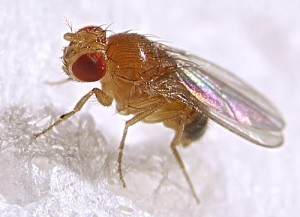 I have been working with Drosophila as a model system for understanding biological processes since 1983. My graduate work was in understanding the role of biochemical pathways, in particular folate-related and neurotransmitter synthesis pathways, in the development of the nervous system. I became interested in nervous system excitability and behavior during my postdoctoral years and have worked on ion channel and “bang-sensitive” mutants throughout much of my later career. These mutants have served as a model for epilepsy and neurodegenerative disease and have been more recently linked to altered pain response and alcohol sensitivity. My projects in this area revolved around these mutants as models for human disease.
I have been working with Drosophila as a model system for understanding biological processes since 1983. My graduate work was in understanding the role of biochemical pathways, in particular folate-related and neurotransmitter synthesis pathways, in the development of the nervous system. I became interested in nervous system excitability and behavior during my postdoctoral years and have worked on ion channel and “bang-sensitive” mutants throughout much of my later career. These mutants have served as a model for epilepsy and neurodegenerative disease and have been more recently linked to altered pain response and alcohol sensitivity. My projects in this area revolved around these mutants as models for human disease.
Epilepsy
Reversible paralysis has been successfully used in Drosophila to genetically dissect the proteins necessary for proper development and function of the nervous system. In particular, we study a class of genes in Drosophila known as bang-sensitive paralytics. When a detrimental change or mutation is made in any one of genes, the flies carrying these mutations seize and paralyze in response to mechanical shock. These flies also display seizures, failures and abnormal facilitation in physiological recordings. We are interested in studying these genes at a systems level and a molecular level to find out what neural processes are defective in these mutants. Studies in the lab utilize many techniques: biochemical, pharmacological, molecular genetic, physiological and behaviorial analyses. Evidence gathered so far indicates that these genes are involved in development of the molecular characteristics of specific neurons, and in maintaining the electrical properties of the neuron and in nervous system aging. The excitability and other aspects of these phenotypes are modifiable by diet. Alterations of protein/carbohydrate levels as well as antioxidant feeding can alter seizure, aging measures and mitochondrial activity. Our research on these mutants has applications in the fields of learning and memory, human aging, epilepsy and neurodegenerative disease.
Publications related to this project:
Wang, X., Reynolds, E.R., Deak, P., and Hall, L.M. (1997). The seizure locus encodes the Drosophila homologue of the HERG potassium channel. Journal of Neuroscience 17 (3): 882-890.
Nyako*, M., Marks*, C., Sherma, J. and Reynolds, E.R. (2001) Tissue-specific and developmental effects of the easily shocked mutation on ethanolamine kinase activity and phospholipid composition in Drosophila melanogaster. Biochemical Genetics 39(9-10): 339-349.
Zhang, H., Tan, J., Reynolds, E., Kuebler, D., Faulhaber, S., and Tanouye, M. (2002). The Drosophila slamdance gene: a mutation in an aminopeptidase can cause seizure, paralysis and neuronal failure. Genetics 162: 1283-1299.
Reynolds, E.R., Stauffer*, E.A., Feeney*, L., Rojahn*, E., Jacobs*, B., and McKeever*, C. (2004). Treatment with the antiepileptic drugs phenytoin and gabapentin ameliorates seizure and paralysis of Drosophila bang-sensitive mutants. Journal of Neurobiology 58: 503-513.
Woinski*, Alexander and Elaine R. Reynolds (2016) Magnesium supplementation reduces seizure and paralysis in technical knockout and easily shocked bang-sensitive mutants.. Dros. Inf. Serv. 99: 58-60.
Reynolds, ER. (2018) Shortened lifespan and other age-related defects in bang-sensitive Drosophila . G3: GENES, GENOMES, GENETICS vol. 8 no. 12 pp. 3953-3960. https://doi.org/10.1534/g3.118.200610
Caslin B*, Thomas K*, Austin A*, Dellovade D*, Nganga S* and Reynolds ER. A relationship between diet, seizure, and age-related phenotypes in bang-sensitive mutants of Drosophila melanogaster. In preparation.
Papers available upon request
Parkinson’s Disease
Parkinson’s disease (PD) is a chronic, neurodegenerative disorder that affects 4 to 5 million people worldwide. PD is characterized by motor impairments such as tremors and rigidity due to dopaminergic (DA) neuronal death in the substantia nigra pars compacta. Several mutations with impaired mitochondrial function including LRRK2 (Leucine-rich repeat kinase 2) have been shown to impact PD onset. Production of reactive oxygen species by impaired mitochondria is associated with aging and neurodegeneration and most likely contributes to development of PD. Diet has been shown to be an environment factor that can impact PD progression. Antioxidants in particular have been shown to exhibit neuroprotective effects by decreasing oxidative damage and activating certain protective hormetic pathways. We have been feeding polyphenols, a type of antioxidant, to the LRRK2 model of flies and have been looking for protective effects on neurons, improved lifespan and reduce parkinsonian symptoms. While no effect on lifespan was observed, addition of polyphenol did reduce motor symptoms and improved DA neuron survival.
Papers and abstracts related to this project:
Bayer R* and Reynolds ER (2014). Polyphenol Treatment for Parkinson’s Disease in a LRRK2 Drosophila melanogaster Model: Targeting the Intersection of Environmental and Genetic Causes. Lehigh Valley Society for Neuroscience Meeting, April 2014 at DeSales University, Allentown PA.
Corbin K*, Walko I*, Dacy B*, and Reynolds ER (2015). The effect of diet on a fly model of Parkinson’s disease. J. Penn. Acad. Sci. 89(2): 7.
Cantor B*, Bayer R* and Reynolds ER (2015). Polyphenol Treatment for Parkinson’s Disease in a LRRK2 Drosophila melanogaster Model Improves Motor Function and Dopaminergic Neuron Survival, Poster at the Lehigh Valley Society for Neuroscience Meeting April 2015 at Lehigh University, Bethlehem, PA.
Bayer*R, Skurla*M, and Reynolds ER (2017). Polyphenols as Treatment at the Intersection of Environmental and Genetic Causes of Parkinson’s Disease in a LRRK2 Model. 2017, Dros. Inf. Serv. 100: 135-137.